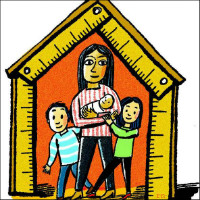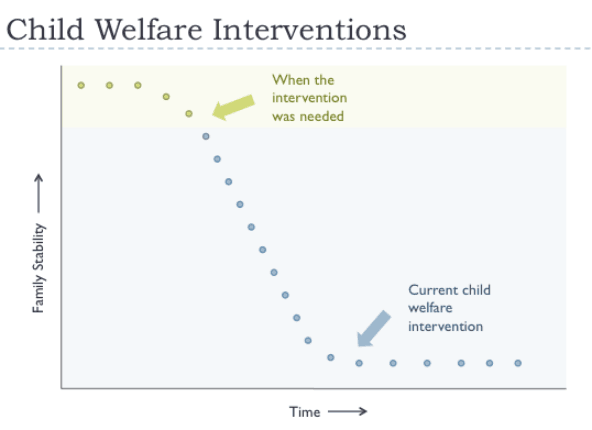When I became director at the Baltimore City Department of Social Services in 2008, it was among the most troubled agencies of its kind in the country. The department serves low-income and vulnerable citizens and oversees services including child protection and foster care. When I started, all of the things we worry most about in child welfare services were true: The agency struggled to keep track of its children, a large share of children were living in group homes, children lingered in foster care for years, or even their entire childhood, and some were suffering injury and dying while in foster care. I am proud to say we were able to turn those statistics around. Robust and sustained reform led to a 70 percent reduction in the number of children in foster care over a seven-year period. We accomplished this feat through an unwavering focus on mission, by developing the ability to use data to drive decision-making, and by building a discipline around completing tasks. You can hear more about this dramatic success in my 2014 TEDx Baltimore talk.
When we had achieved measurable success, though, the dust settled and revealed a larger set of problems that I had not anticipated. In short, I saw that if what we intended was to make the world a better place, then we were deploying the wrong intervention. My department was intervening after a family had already become highly unstable, meaning that by the time we arrived, we were left with no other option than to remove a child from their parents. This invariably led to more problems moving forward. A childhood spent outside the boundaries of a permanent family can make it harder for children to forge healthy relationships or mature into pro-social adults. I continue to believe that the concept of separating a child from their family is in error and that it should be used in the rarest of circumstances. At the same time, we can’t very well leave children in peril. So how can we intervene to avoid having to remove kids from families?

Fortunately, we have at our disposal an extraordinary amount of data to inform our answer. Imagine that a family’s stability could be graphed over time. Most families are doing fine. In all families, bad things sometimes happen: the car is totaled, someone gets seriously ill, or someone dies. Most families are able to immediately respond in a way that avoids disaster. They rent a car or take sick time or someone brings over a casserole. But some families aren’t able to respond this way, and so their level of stability plummets. Instability brings on all the really bad stuff: evictions, addiction, domestic violence, abuse, and neglect.
The longer that instability lasts, the harder it is for a family to rise back up. At that point, placing children in foster care may be the only option available to us. But what these families really need is intervention at the top of the curve—when they are beginning to struggle but are still relatively stable, and when the intervention wouldn’t involve breaking up families.

We can shift the point of intervention by focusing on data points that provide child welfare services much earlier indicators that a family is struggling. Chronic absenteeism from school in young children, arrests in early adolescence, the electricity being cut off, children appearing in ERs for psychiatric interventions, and families arriving at homeless shelters are all great examples of data that indicate earlier moments when milder interventions might be able to stave off the dissection of a family unit. By arriving early in the trajectory, we can help support vulnerable families as they respond to misfortune.
Efforts of this nature by my department have shown early signs of success in Baltimore. Under cautious and thoughtfully crafted agreements, we are privy to information from partners, such as public schools, about families that are showing early signs of distress. We can then intervene with methods designed to turn a family’s trajectory in a positive direction. Child welfare caseworkers can engage a family while their children are still at home and provide coaching, connections to community resources, access to treatment, and a steady presence in sometimes chaotic households. Because they arrive at the earliest signs of trouble, they are able to offer support long before things have gotten so bad that we have to send in a child protection investigator. Using this approach, we are able to create partnerships that support family stability and avoid separating a child from their parents.
This is important work. But the fact is that even when we get good at it, we’ll still be moving too slowly if we remain tied to a model of child welfare that manages one case at a time and defines positive outcomes only in terms of individual children. This approach ignores broader demographic trends in many struggling parts of urban America. In Baltimore, like most cities, a subset of neighborhoods post awful outcomes across the spectrum of predictors of family stability. One particular Baltimore neighborhood is the source of almost 40 percent of the reports of child abuse that come to my organization each year. Were you to drive through the area you would clearly see chronic unemployment, vacant housing, rampant substance abuse, a general lack of community resources, and the constant threat of violence. It seems painfully obvious that the factors that contribute to instability occur not in the privacy of individual households, but across entire neighborhoods. And yet we wait for the call, intervening family by family and failing to notice that our efforts are not producing a net effect on the community.
As an alternative, we could start by taking a broader frame of reference. For instance, we could map a particular neighborhood using three years of data for what we call a child’s “home of origin,” the address where a child lived when we took them from their parents. We could analyze this data less to see the specifics of individual homes and more to look for patterns. We might notice that a significant portion of the children who came to the agency’s attention were infants who were injured after having been shaken. We might then theorize that there is an insufficient amount of information in the neighborhood about the dangers of shaking a baby and about what one could do when their newborn will not stop crying. Those insights, which are uniquely available to child welfare services, could inform the decisions of neighborhood leaders: what the preacher might say from the pulpit, what the pediatrician might say at the well-baby visit, what the principal might send home in the backpack. Using data in this way can enable social services to flood the neighborhood with the kind of information and support that would allow vulnerable families to make course adjustments when needed.
These choices would mean that child welfare departments could continue to do the important work of managing individual cases, but with critical insights that could help direct our work at the neighborhood level. Combined, these efforts might actually lead to the net effect that I believe we all hope for.
This shift in approach will be an enormous challenge, largely because the way we measure success in child welfare systems now is by counting negative outcomes such as reports of abuse and neglect, the number of children in foster care, and the number of children who cannot return to their own families. A better approach would ask that we consider additional ways of measuring performance and the possibility that the absence of a negative outcome is itself a positive. Fewer reports of abuse and neglect, fewer children in foster care, and fewer adoptions—if due at least in part to the choice to intervene with families earlier—would actually represent better outcomes because we would have kept more children safe at home with their own families. It will be challenging to learn to see the absence of these negative statistics as a measure of success, but it’s a challenge worth pursuing.
Support SSIR’s coverage of cross-sector solutions to global challenges.
Help us further the reach of innovative ideas. Donate today.
Read more stories by Molly McGrath Tierney.

